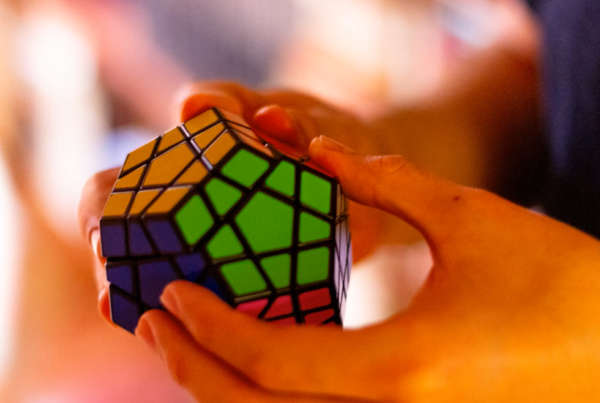
You’re walking around on a normal Spring day in the city of Amsterdam. You’re seeing people on boats in the canal. Makes enough sense. You cross a bridge and see beds of vibrant flowers. Another normal sight in this city! But wait, is that a kangaroo you see in Vondel Park? While it may seem that one of these things is not like the others, they actually all have a commonality: you are hallucinating them. Let me explain.
You’re walking around on a normal Spring day in the city of Amsterdam. You’re seeing people on boats in the canal. Makes enough sense. You cross a bridge and see beds of vibrant flowers. Another normal sight in this city! But wait, is that a kangaroo you see in Vondel Park? While it may seem that one of these things is not like the others, they actually all have a commonality: you are hallucinating them. Let me explain.

Photograph taken by Pika Ivana Kostanjšek
Models: Nika Erjavec, Nika Brecelj & Tjaša Šušnjar

Photograph taken by Pika Ivana Kostanjšek
Models: Nika Erjavec, Nika Brecelj & Tjaša Šušnjar
One of the most fundamental misconceptions we have about the world is that we experience it how it is. When we go about our day walking through Amsterdam, doing our job, going out with friends, or whatever else, we take what we perceive as being reality. However, we cannot access full reality through our senses. Our senses are not designed to pick up on every detail in our environment, just like our brain cannot process every piece of data that the world throws at it at any second of the day. For example, if you have ever attempted to make your way through a crowded and hectic food market, you know that there is much more going on than your senses and brain can process. Our experience of the world is therefore restricted to the anatomy and capacity of our senses and our brain.
Think about this: ‘colors’ don’t exist in the physical reality, but emerge from how our eyes and brain process the light frequencies that are absorbed in or reflected from objects in our environment. Therefore, in a way, we see colors that aren’t there. But it doesn’t stop here: The input our brain receives from our eyes is ‘noisy’, lacking high resolution and color, amongst other things, at many points in our visual field. It is then up to our brains to piece the puzzle together to create the clean, colorful and coherent visual experiences that we have. Another classic example of how our brain fools us into seeing coherently is our ‘blind spot’. We all have this ‘blind spot’, and it emerges from the area in the back of our eyes where the optic nerve connects to our brain. Since this area lacks photoreceptor cells – the cells that pick up on visual signals – we are blind in that part of our visual field. The reason we never notice our blind spot despite it being in the middle of our visual field is due to our brain’s immaculate ability to fill in the gaps for us. If the brain can make us see things that are not actually there, then how far removed are these ‘normal’ precepts from hallucinations, which are commonly defined as an experience involving the apparent perception of something not present?
“If hallucination is kind of an uncontrolled perception, then a perception is a controlled hallucination. [...] We have hallucinations all the time, except when we agree on them, then we call it reality- Anil Seth”
Our normal visual experience, and how the brain transforms noisy or incomplete information from our eyes to generate a clear, stable, and coherent perception of things, is a striking yet unresolved phenomena. However, much evidence points towards a mechanism utilized by the brain referred to as “predictive coding”. Predictive coding is based on the idea that our brain uses previous experiences to assess incoming information from our senses. It uses this previous experience to generate predictions about the environment. In the next step, it compares the predictions against the incoming input from our eyes to generate the visual experience most likely to represent the outside world. Taking previous knowledge and experiences into consideration when assessing information from the eyes is useful because the input from our eyes is noisy and therefore not necessarily reliable. For example, after being on planet earth for xy number of years, you can easily rely on assumptions the brain makes about what you may encounter. No need to process every little detail in your visual field, especially because it may arrive at your brain in bad resolution anyway. For example, if you see something the size of a dog or cat running across a park in Amsterdam, you know that will indeed probably be a dog or a cat, which makes it easier to process the information instead of also taking kangaroos, leopards, beavers or any other animals into consideration. Making predictions and comparing them to sensory data from the eyes seems to be the basis for just about any visual experience we have. In short, we don’t just perceive the world, our brains actively construct it.
Another good example recently posed by Yon and Frith (2021) asks you to imagine you are in a sandstorm in the desert. The brain sees something moving through the sandstorm in the distance. Since you are in the desert, the brain predicts that this object in the distance is a camel. Whether you will consciously perceive the camel depends on how reliable the brain finds both its predictions and incoming data from the eyes. If the sandstorm makes it too difficult to see clearly – and eyesight is noisy anyway – your brain may find the previous knowledge that camels exist frequently in the desert more reliable than the incoming noisy information. In that case, it may generate a conscious perception of a camel walking through the sandstorm. If the brain finds the incoming sensory information to be more reliable, then you continue to see a vague shadow.
But are actively constructed percepts full-blown hallucinations? Recently, Yon and Frith (2021) argued that both rely on the same mechanism: predictive coding. Thus, hallucinations are not that much different from ‘normal’ vision. The difference is that hallucinations occur when the brain assesses its predictions to be more reliable than it objectively should. Thus, in the example with the sandstorm, if we rely too much on our predictions based on previous experience as compared to what we really perceive through our eyes, we may see a camel when in reality, there is none. Similarly, if our brain makes a very strong prediction to see a kangaroo in Amsterdam, then we may spot one. And when our brain strongly expects to hear voices, then they may actually appear to start talking. In other words, when perceptual predictions are too strong, then the result looks like the kind of experience people may have in altered states or even in something you may call psychosis. As Anil Seth said in his Ted Talk, “if hallucination is kind of an uncontrolled perception, then a perception is a controlled hallucination. […] We have hallucinations all the time, except when we agree on them, then we call it reality”.
There are many examples of when the brain constructs our perceptions, just like during a hallucination. This suggests that normal vision and hallucination might be closer related than previously thought: they might be on a spectrum. While we can use the predictive coding framework to argue that hallucinations are not far from normal visual experiences, it remains to be seen how and when the brain places irrational reliability on previous experiences and predictions. As a result, the point of transition from a ‘normal’ visual experience to a hallucination has yet to be determined. But whether we have controlled hallucinations or uncontrolled perceptions – we are the co-creator of all of them.
References
-
Friston, K. (2010). The free-energy principle: a unified brain theory? Nature Reviews Neuroscience, 11(2), 127–138. https://doi.org/10.1038/nrn2787
-
Otten, M., Pinto, Y., Paffen, C. L. E., Seth, A. K., & Kanai, R. (2016). The Uniformity Illusion. Psychological Science, 28(1), 56–68. https://doi.org/10.1177/0956797616672270
-
Seth, A. (n.d.). Your brain hallucinates your conscious reality. TED Talks. https://www.ted.com/talks/anil_seth_your_brain_hallucinates_your_conscious_reality
-
Yon, D., & Frith, C. D. (2021). Precision and the Bayesian brain. Current Biology. https://doi.org/10.31234/osf.io/t3yxj
One of the most fundamental misconceptions we have about the world is that we experience it how it is. When we go about our day walking through Amsterdam, doing our job, going out with friends, or whatever else, we take what we perceive as being reality. However, we cannot access full reality through our senses. Our senses are not designed to pick up on every detail in our environment, just like our brain cannot process every piece of data that the world throws at it at any second of the day. For example, if you have ever attempted to make your way through a crowded and hectic food market, you know that there is much more going on than your senses and brain can process. Our experience of the world is therefore restricted to the anatomy and capacity of our senses and our brain.
Think about this: ‘colors’ don’t exist in the physical reality, but emerge from how our eyes and brain process the light frequencies that are absorbed in or reflected from objects in our environment. Therefore, in a way, we see colors that aren’t there. But it doesn’t stop here: The input our brain receives from our eyes is ‘noisy’, lacking high resolution and color, amongst other things, at many points in our visual field. It is then up to our brains to piece the puzzle together to create the clean, colorful and coherent visual experiences that we have. Another classic example of how our brain fools us into seeing coherently is our ‘blind spot’. We all have this ‘blind spot’, and it emerges from the area in the back of our eyes where the optic nerve connects to our brain. Since this area lacks photoreceptor cells – the cells that pick up on visual signals – we are blind in that part of our visual field. The reason we never notice our blind spot despite it being in the middle of our visual field is due to our brain’s immaculate ability to fill in the gaps for us. If the brain can make us see things that are not actually there, then how far removed are these ‘normal’ precepts from hallucinations, which are commonly defined as an experience involving the apparent perception of something not present?
“If hallucination is kind of an uncontrolled perception, then a perception is a controlled hallucination. [...] We have hallucinations all the time, except when we agree on them, then we call it reality- Anil Seth”
Our normal visual experience, and how the brain transforms noisy or incomplete information from our eyes to generate a clear, stable, and coherent perception of things, is a striking yet unresolved phenomena. However, much evidence points towards a mechanism utilized by the brain referred to as “predictive coding”. Predictive coding is based on the idea that our brain uses previous experiences to assess incoming information from our senses. It uses this previous experience to generate predictions about the environment. In the next step, it compares the predictions against the incoming input from our eyes to generate the visual experience most likely to represent the outside world. Taking previous knowledge and experiences into consideration when assessing information from the eyes is useful because the input from our eyes is noisy and therefore not necessarily reliable. For example, after being on planet earth for xy number of years, you can easily rely on assumptions the brain makes about what you may encounter. No need to process every little detail in your visual field, especially because it may arrive at your brain in bad resolution anyway. For example, if you see something the size of a dog or cat running across a park in Amsterdam, you know that will indeed probably be a dog or a cat, which makes it easier to process the information instead of also taking kangaroos, leopards, beavers or any other animals into consideration. Making predictions and comparing them to sensory data from the eyes seems to be the basis for just about any visual experience we have. In short, we don’t just perceive the world, our brains actively construct it.
Another good example recently posed by Yon and Frith (2021) asks you to imagine you are in a sandstorm in the desert. The brain sees something moving through the sandstorm in the distance. Since you are in the desert, the brain predicts that this object in the distance is a camel. Whether you will consciously perceive the camel depends on how reliable the brain finds both its predictions and incoming data from the eyes. If the sandstorm makes it too difficult to see clearly – and eyesight is noisy anyway – your brain may find the previous knowledge that camels exist frequently in the desert more reliable than the incoming noisy information. In that case, it may generate a conscious perception of a camel walking through the sandstorm. If the brain finds the incoming sensory information to be more reliable, then you continue to see a vague shadow.
But are actively constructed percepts full-blown hallucinations? Recently, Yon and Frith (2021) argued that both rely on the same mechanism: predictive coding. Thus, hallucinations are not that much different from ‘normal’ vision. The difference is that hallucinations occur when the brain assesses its predictions to be more reliable than it objectively should. Thus, in the example with the sandstorm, if we rely too much on our predictions based on previous experience as compared to what we really perceive through our eyes, we may see a camel when in reality, there is none. Similarly, if our brain makes a very strong prediction to see a kangaroo in Amsterdam, then we may spot one. And when our brain strongly expects to hear voices, then they may actually appear to start talking. In other words, when perceptual predictions are too strong, then the result looks like the kind of experience people may have in altered states or even in something you may call psychosis. As Anil Seth said in his Ted Talk, “if hallucination is kind of an uncontrolled perception, then a perception is a controlled hallucination. […] We have hallucinations all the time, except when we agree on them, then we call it reality”.
There are many examples of when the brain constructs our perceptions, just like during a hallucination. This suggests that normal vision and hallucination might be closer related than previously thought: they might be on a spectrum. While we can use the predictive coding framework to argue that hallucinations are not far from normal visual experiences, it remains to be seen how and when the brain places irrational reliability on previous experiences and predictions. As a result, the point of transition from a ‘normal’ visual experience to a hallucination has yet to be determined. But whether we have controlled hallucinations or uncontrolled perceptions – we are the co-creator of all of them.
References
-
Friston, K. (2010). The free-energy principle: a unified brain theory? Nature Reviews Neuroscience, 11(2), 127–138. https://doi.org/10.1038/nrn2787
-
Otten, M., Pinto, Y., Paffen, C. L. E., Seth, A. K., & Kanai, R. (2016). The Uniformity Illusion. Psychological Science, 28(1), 56–68. https://doi.org/10.1177/0956797616672270
-
Seth, A. (n.d.). Your brain hallucinates your conscious reality. TED Talks. https://www.ted.com/talks/anil_seth_your_brain_hallucinates_your_conscious_reality
-
Yon, D., & Frith, C. D. (2021). Precision and the Bayesian brain. Current Biology. https://doi.org/10.31234/osf.io/t3yxj



